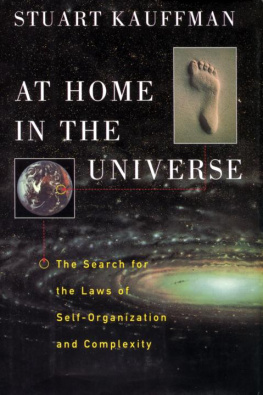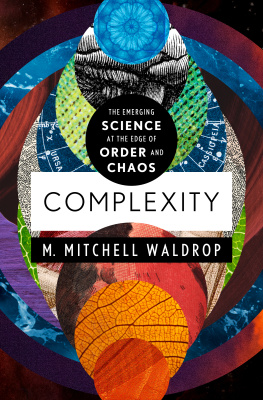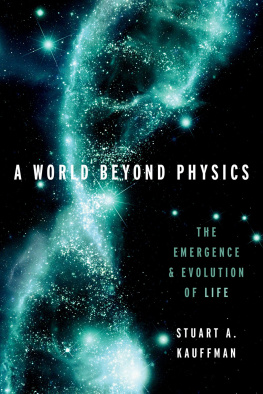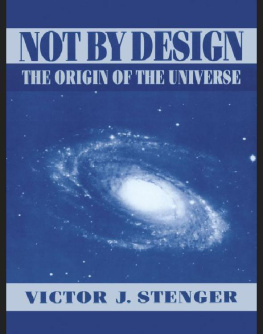Stuart Kauffman - At Home in the Universe: The Search for the Laws of Self-Organization and Complexity
Here you can read online Stuart Kauffman - At Home in the Universe: The Search for the Laws of Self-Organization and Complexity full text of the book (entire story) in english for free. Download pdf and epub, get meaning, cover and reviews about this ebook. year: 1995, publisher: Oxford University Press, USA, genre: Romance novel. Description of the work, (preface) as well as reviews are available. Best literature library LitArk.com created for fans of good reading and offers a wide selection of genres:
Romance novel
Science fiction
Adventure
Detective
Science
History
Home and family
Prose
Art
Politics
Computer
Non-fiction
Religion
Business
Children
Humor
Choose a favorite category and find really read worthwhile books. Enjoy immersion in the world of imagination, feel the emotions of the characters or learn something new for yourself, make an fascinating discovery.
- Book:At Home in the Universe: The Search for the Laws of Self-Organization and Complexity
- Author:
- Publisher:Oxford University Press, USA
- Genre:
- Year:1995
- Rating:4 / 5
- Favourites:Add to favourites
- Your mark:
At Home in the Universe: The Search for the Laws of Self-Organization and Complexity: summary, description and annotation
We offer to read an annotation, description, summary or preface (depends on what the author of the book "At Home in the Universe: The Search for the Laws of Self-Organization and Complexity" wrote himself). If you haven't found the necessary information about the book — write in the comments, we will try to find it.
We all know of instances of spontaneous order in nature--an oil droplet in water forms a sphere, snowflakes have a six-fold symmetry. What we are only now discovering, Kauffman says, is that the range of spontaneous order is enormously greater than we had supposed. Indeed, self-organization is a great undiscovered principle of nature. But how does this spontaneous order arise? Kauffman contends that complexity itself triggers self-organization, or what he calls order for free, that if enough different molecules pass a certain threshold of complexity, they begin to self-organize into a new entity--a living cell. Kauffman uses the analogy of a thousand buttons on a rug--join two buttons randomly with thread, then another two, and so on. At first, you have isolated pairs; later, small clusters; but suddenly at around the 500th repetition, a remarkable transformation occurs--much like the phase transition when water abruptly turns to ice--and the buttons link up in one giant network. Likewise, life may have originated when the mix of different molecules in the primordial soup passed a certain level of complexity and self-organized into living entities (if so, then life is not a highly improbable chance event, but almost inevitable). Kauffman uses the basic insight of order for free to illuminate a staggering range of phenomena. We see how a single-celled embryo can grow to a highly complex organism with over two hundred different cell types. We learn how the science of complexity extends Darwins theory of evolution by natural selection: that self-organization, selection, and chance are the engines of the biosphere. And we gain insights into biotechnology, the stunning magic of the new frontier of genetic engineering--generating trillions of novel molecules to find new drugs, vaccines, enzymes, biosensors, and more. Indeed, Kauffman shows that ecosystems, economic systems, and even cultural systems may all evolve according to similar general laws, that tissues and terra cotta evolve in similar ways. And finally, there is a profoundly spiritual element to Kauffmans thought. If, as he argues, life were bound to arise, not as an incalculably improbable accident, but as an expected fulfillment of the natural order, then we truly are at home in the universe.
Kauffmans earlier volume, The Origins of Order, written for specialists, received lavish praise. Stephen Jay Gould called it a landmark and a classic. And Nobel Laureate Philip Anderson wrote that there are few people in this world who ever ask the right questions of science, and they are the ones who affect its future most profoundly. Stuart Kauffman is one of these. In At Home in the Universe, this visionary thinker takes you along as he explores new insights into the nature of life.
Stuart Kauffman: author's other books
Who wrote At Home in the Universe: The Search for the Laws of Self-Organization and Complexity? Find out the surname, the name of the author of the book and a list of all author's works by series.














 Lit my window, just west of Santa Fe, lies the near spiritual landscape of northern New Mexico-barrancas, mesas, holy lands, the Rio Grande-home to the oldest civilization in North America. So much, so ancient and modern, pregnant with the remote past and the next millennium mingle here, haphazardly, slightly drunk with anticipation. Forty miles away lies Los Alamos, brilliance of mind, brilliance of flashing light that desert dawning in 1945, half a century ago, half our assumptions ago. Just beyond spreads the Valle Grande, remains of an archaic mountain said to have been over 30,000 feet high that blew its top, scattering ash to Arkansas, leaving obsidian for later, finer workings.
Lit my window, just west of Santa Fe, lies the near spiritual landscape of northern New Mexico-barrancas, mesas, holy lands, the Rio Grande-home to the oldest civilization in North America. So much, so ancient and modern, pregnant with the remote past and the next millennium mingle here, haphazardly, slightly drunk with anticipation. Forty miles away lies Los Alamos, brilliance of mind, brilliance of flashing light that desert dawning in 1945, half a century ago, half our assumptions ago. Just beyond spreads the Valle Grande, remains of an archaic mountain said to have been over 30,000 feet high that blew its top, scattering ash to Arkansas, leaving obsidian for later, finer workings.